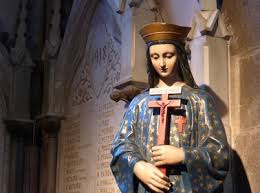Besides being the universal memorial of Saint Anthony, Abbot and Desert Father, one of the primary founders of monasticism – especially of the eremitical variety, the way of hermits, who live solitary lives of prayer and penance – we also celebrate the anniversary of the vision of Our Lady of Pontmain – devotion to which, or to whom, should be much more widely known and venerated.
The story is a simple and brief one, as are most of the authentic visions of the Mother of God: In 1871 the Franco-Prussian war had just begun, with Napoleon III (the nephew of Bonaparte) declaring war on the dominant army of Bismarck. The Prussians with their superior military and firepower, easily had the better of it, storming through France, as the Nazis would do just a half-century later.
Outside the small village Pontmain, the Prussian army was advancing on a cold winter’s night in January, when the two younger boys of the Barbedette family, Joseph and Eugène, helping their father in the barn, saw against the clear, starry night sky a beautiful woman smiling at them, wearing a blue dress, itself covered in stars, with a black veil and a golden crown, with a smile of ineffable tenderness. The local schoolteacher, Sister Vitaline, was called over, and although she could not see the apparition – only three gold stars in a triangle – two other girls, Françoise Richer and Jeanne-Marie Lebosse, aged 9 and 11 – could. He has hidden Himself from the wise and prudent, and revealed Himself to little ones…
They prayed the rosary – for what else would one do? – and the stars on the Lady’s dress multiplied until it was almost entirely gold, and a banner unfurled beneath her feet, Mais priez mes enfants, Dieu vous exaucera, “But pray my little children, God will hear you in time”, adding, somewhat mysteriously, “My Son allows Himself to be touched”.
As the children began to sing the hymn Mother of Hope, the Lady laughed and joined in, keeping time with her hands, confirming the principle that music and devotion always go together, and why would not Our Lady be musical? When they began the mournful “My Sweet Jesus”, the Lady became sad, with a red crucifix appearing in her hands, with ‘Jesus Christ’ above. But then when they launched into the very apt Ave Maris Stella, the cross vanished, and her smile returned, but with a hint of melancholy.
After about three hours of such prayer and song, two small crosses appeared on her shoulders, and our Lady disappeared behind a cloud.
The Prussians meanwhile had mysteriously stopped their advance, their commander admitting that “We cannot go further. Yonder, in the direction of Brittany, there is an invisible Madonna blocking the way”. If one knows anything about 19th century Prussians, this is not the way they normally spoke. The war ended soon afterward in an armistice, and the thirty-eight conscripted men from the village all returned home safe.
All four of the visionaries consecrated their lives to God, Joseph becoming an Oblate of Mary Immaculate, his brother Eugene a diocesan priest; Francoise dedicated her life as a housekeeper for the rectory, and Jeanne-Marie, a nun.
Devotion to Our Lady, Mother of Hope – as the apparition is so named – was approved by the local Bishop on February 2nd, 1872, authorizing a sanctuary to be built, which was raised to the status of a basilica by Pope Saint Pius X in 1905, further approved by Pius XI and Cardinal Pacelli, later Pope Pius XII, with a crowning of the official statue by Cardinal Verdier, Archbishop of Paris, on July 24, 1934.
We could use more hope and joy in our world – gaudium et spes – so devotion to the laughing, musical Madonna is more than apt, even necessary. Pray to her today, and may God provide for all the desires of our hearts.











